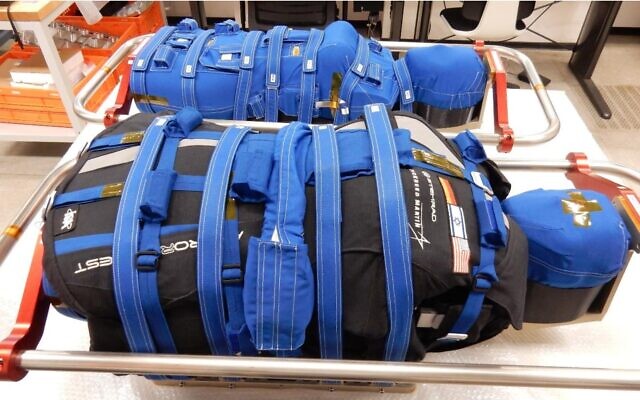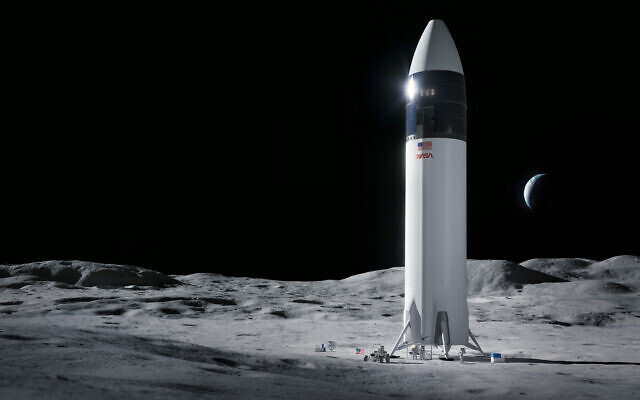Israeli company StemRad, a developer of radiation protection suits for space explorers, emergency responders, defense forces, nuclear industry workers, and medical personnel, is preparing for a major demonstration of its technology as part of NASA’s Artemis I mission later this month.
NASA’s Artemis program, first unveiled in 2017, aims to land astronauts on the lunar surface in the next few years and establish a long-term human presence on the Moon as a warm-up for future missions to Mars. Israel officially signed onto the Artemis program in January.
The Artemis I mission, set for August 29, will be the first uncrewed test flight of NASA’s new Space Launch System (SLS) rocket and the Orion Spacecraft, which will eventually carry astronauts from Earth to lunar orbit and back. Artemis II, scheduled for 2024, will be the first crewed flight of the SLS and the Orion. Artemis III is planned as the first crewed mission to land on the Moon in 2025 and the first crewed flight of the Starship HLS (Human Landing System) lander, under development by Elon Musk’s SpaceX.
As part of the uncrewed Artemis I mission, StemRad will assess the protective qualities of the AstroRad, an anti-radiation suit co-developed with Lockheed Martin to protect vital organs from harmful gamma radiation, on human analogs (or mannequins) aboard the Orion.
The humanoid stand-ins, called “anthropometric radiation phantoms,” are provided by the German Aerospace Center (DLR), a partner to a study of the AstroRad’s performance in space. Dubbed the Matroshka AstroRad Radiation Experiment (MARE), the study will provide a comparative analysis of two female phantoms — one called Zohar, which will wear the AstroRad, and its unprotected counterpart, Helga.
The phantoms (called matroshkas in space contexts), are made of materials that mimic human bones, soft tissues, and organs in female bodies, and contain thousands of radiation detectors that will provide researchers with a high-resolution map of radiation dose deposition in humans.

The assembled female-formed mannequins Zohar (foreground), with the AstroRad suit, and Helga (background), without. (NASA/StemRad)
The study will represent the first time that radiation penetration into the human body will be measured in deep space.
The experiment is years in the making and a big moment for StemRad, which first signed on to be part of the mission in 2018.
StemRad CEO and chief scientific officer Dr. Oren Milstein told The Times of Israel on Sunday that he “had doubts it would happen, there were moments of anxiety, but we are now close to the finish line.”
Speaking from Tampa, Florida, where he is now based to develop the market for StemRad’s products, Milstein said there were feelings of excitement and fulfillment as the company hopes to “validate the technology and be able to fly on crewed missions.”
Milstein explained that female forms were chosen because “women are more sensitive to the effects of space radiation, so we thought we would conquer the tougher challenge first,” but the AstroRad is designed to protect both men and women.
Besides, NASA has said the moonwalkers on the Artemis III will include the first woman (and the first person of color) to make the trip, he noted.
Radiation protection first
Milstein said StemRad was the only company in the world working on radiation protection using advanced technologies.
The Israeli-American company was set up after the 2011 Fukushima nuclear disaster to develop protection for first responders exposed to the highly penetrating gamma radiation emitted in such events. StemRad’s radiation suits are now used to protect workers at nuclear reactors, radiological first responders, physicians and military forces, as well as astronauts.
StemRad’s approach doesn’t try to protect the whole body, but aims to selectively protect organs with exceptional sensitivity to radiation, like bone marrow in the hip or in the vertebrae, and the gastrointestinal system.

A photo of the AstroRad suit taken by the ISS crew in January, 2020. (NASA)
Exposure to gamma radiation can result in radiation sickness (formally known as acute radiation syndrome) — the accelerated destruction of the blood cells and the inability of the body to replenish them due to the damage sustained to bone marrow, which is needed to generate new cells. Fifty percent of the body’s bone marrow is located in the groin and midsection areas — the parts StemRad suits protects, ensuring that workers are protected against the effects of radiation sickness but are able to maintain freedom of movement needed to assist others.
For the AstroRad, StemRad extended protection to the torso to shield tissues and organs such as the lungs and the colon to reduce events that lead to radiation exposure-induced death (REID) like cancer, and lessen the possibility of radiation sickness due to solar particle events (SPE). SPEs are solar phenomena in which the sun emits radiation during magnetic storms. They can pose serious health risks to astronauts on space missions.

The AstroRad’s protective core. (StemRad)
Milstein explained that the Orion spacecraft carrying the AstroRad-outfitted Zohar and Helga will journey through low Earth orbit and deep space where it will be exposed to intense radiation and possibly a solar particle event that can trigger radiation sickness to better study the suit’s protective capabilities.
With the right protection against solar energy particles, a crew aboard a spacecraft could continue working and meeting its mission objectives while being shielded.
While an encounter with a solar flare is not assured, the Orion will pass through the Van Allen radiation belts, zones of energetic charged particles that emanate from solar winds. Located in the inner region of Earth’s magnetosphere, these belts provide an opportunity to test the AstroRad suit in conditions similar to a solar particle event.
Over the approximately 40-day mission, StemRad and its partners will be “collecting very important data points to look at how the suit protects Zohar in relation to Helga. We’ll get measurements, and hopefully a solar particle event to study.”

A still image taken from a NASA video of a solar flare that erupted on the right side of the sun on October 2, 2014. (NASA/SDO/ Wiessinger)
These data points will add to existing, ongoing research gathered aboard the International Space Station (ISS), where the AstroRad has been worn by crew since 2019, to examine the usability of the product and allow StemRad to make adjustments ahead of crewed Artemis missions.
“On the ISS, we studied the ergonomic characteristics of the suit. There are things you can only see in microgravity, and we have a list of improvements — nothing major — based on crew feedback,” Milstein said.
After the Artemis I mission, “we’ll have two data sets and we’ll sit together in Israel and the US and decide how best to optimize the vest,” he explained.

A photo of the AstroRad suit on board the ISS crew in January 2020. (NASA)
The considerations will involve comfort, usability, and protection, he said. StemRad will weigh how to “optimize comfort alongside protection without compromising on protection” and decide if a new balance is needed.
“We’ll see if we need to sacrifice on mass or shielding [of the suit], how best to do it and how to do it in the least harmful way,” said Milstein.
StemRad maintains offices in Tel Aviv and Tampa with a “mean and lean” team of about 20 people, Milstein said. The team has biology experts, nuclear physicists, industrial designers, and a scientific team that includes three Nobel laureates.
Milstein said the small company has worked hard over the past decade to build its technology and get to this point, earning grants from the Israel Innovation Authority and Space Florida, and establishing close ties with the Israeli Space Agency, the German Aerospace Center, and Lockheed Martin, the Orion’s lead contractor.
“The team at StemRad has been working extremely hard to design, tweak and improve AstroRad and we are confident that it will pass the challenges presented during the Artemis I mission with flying colors,” Milstein said in a press statement ahead of the launch.
Artemis
Over a dozen countries — including Australia, Canada, the United Arab Emirates, Italy, Mexico, Japan, South Korea, and Israel — are signed on to the NASA-led Artemis Accords, an agreement first inked in October 2020 that establishes partnerships with nations’ space agencies on the Artemis program. The program also includes cooperation with the European Space Agency and US commercial spaceflight operators.

This illustration provided by SpaceX shows the SpaceX Starship human lander design that will carry the first NASA astronauts to the surface of the Moon under the Artemis program. (SpaceX/NASA via AP)
NASA has been seeking to establish a sustainable presence on the Moon and use the lessons to plan a crewed trip to Mars in the 2030s. The Artemis program hopes to build a permanent outpost on the Moon, including an Artemis Base Camp on the surface and a dedicated station, Gateway, in lunar orbit.
The Artemis Accords are built on 10 principles meant to govern civil exploration of outer space and include peaceful exploration, transparency, the release of scientific data, emergency assistance to personnel of all countries, and the use of space resources in compliance with the 1967 Outer Space Treaty, which forms the basis of international space law.
Shoshanna Solomon contributed to his report.